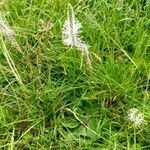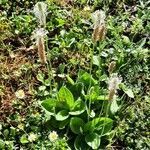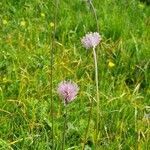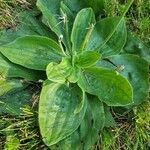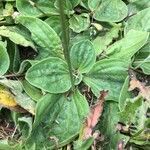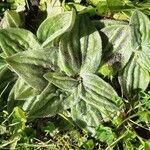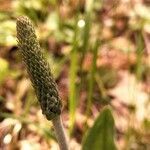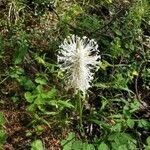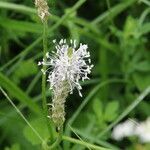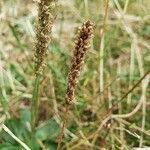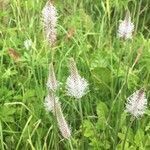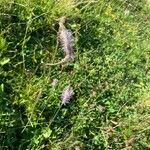Herbs, perennial. Taproot cylindric, thick. Leaves basal; petiole 0.5-8 cm, winged, densely retrorsely pubescent; leaf blade elliptic, ovate, or obovate, 4.5-13 × 1.5-5 cm, papery to thickly papery, white pubescent, veins 7 or 9, base cuneate to attenuate, margin entire or remotely repand-crenate, apex acute. Spikes cylindric, 3-8 cm, densely flowered; peduncle 15-40(-45) cm, white pubescent; bracts narrowly ovate, 2-3 mm, basally and adaxially pubescent, keel thick, apex subacute. Sepals as long as bract, glabrous, keel not extending to apex; lower sepals ovate-elliptic to broadly ovate; upper sepals broadly ovate. Corolla white, glabrous; lobes ovate-elliptic to ovate, 1.7-2.3 mm, patent to reflexed. Stamens lilac turning black when dry, adnate to near base of corolla tube, exserted; anthers oblong, 1.7-1.9 mm. Pyxis ovoid-ellipsoid, 2.5-4 mm, with 2-4 seeds. Seeds yellowish brown to brown, ellipsoid, 1.5-2 mm, shiny, ventral face prominent; cotyledons parallel to ventral side. Fl. Jun-Aug, fr. Jul-Sep. 2n = 12*, 24.
More
Fibrous-rooted perennial; lvs spreading, elliptic to obovate or oblanceolate, acute or tapering at each end, 1–2 dm (petiole included); scapes 1–2 dm, strigose above; spikes dense, narrowly conic, becoming cylindric, 3–10 cm at maturity; bracts and sep subequal, broadly ovate, with broad scarious margins; sep separate; fr thickly ellipsoid, 3 mm, circumscissile at the middle; seeds 2–4, 2 mm; superficially like no. 7 [Plantago lanceolata L.], except for the broader lvs; 2n=12, 24. Native of Eurasia, occasionally found as a weed in waste places in our range.
A low herb. It keeps growing from year to year. It has leaves in a ring. The leaves are narrowly oval and have 7-9 veins. They are covered with dense crisped hairs. The flower spikes are much longer than the leaves. The flowers have pink stamens. They have a scent.
It is a temperate plant. It grows in dry grassy places. In north China it grows on wet banks and mountain slopes between 1,400-2,000 m above sea level.
More
Fields, meadows and lawns. A common weed of lawns and cultivated land, especially on dry or calcareous soils.
